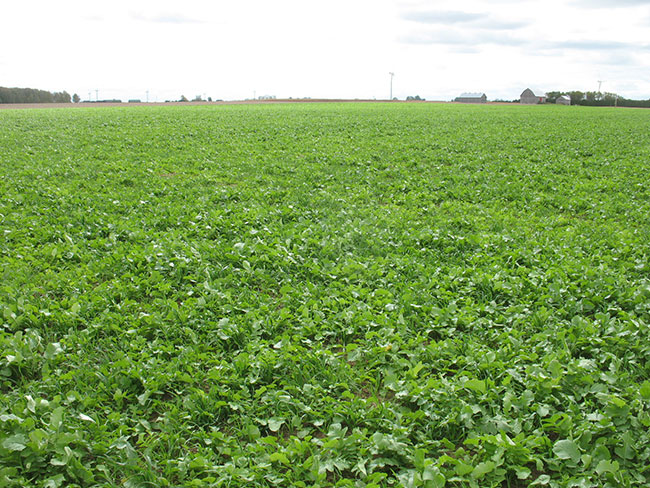
Features
Cover Crops
Cooking with covers
A roundup of cover crop resources and new research for Ontario.
April 3, 2023 By Julienne Isaacs
 Photo courtesy of Peter Sikkema.
Photo courtesy of Peter Sikkema. Keep it simple” – that’s the mantra that begins Soils at Guelph’s new three-part miniseries, “Cooking with Covers.”
The series is meant to underscore three basic principles of cover cropping for first-time or new practitioners: keep it simple, make it pay – and don’t go it alone.
“[The videos] are a way to get advice that’s fun and simple, and to be that starting point for people who haven’t thought about cover crops yet much,” explains Heather White, Soils at Guelph’s knowledge mobilization and communications co-ordinator.
Below, find a roundup of a few other new or improved resources on cover cropping focused on field crop production in Ontario.
University of Guelph
Cover crop “recipes”
Together with the Midwest Cover Crops Council, Soils at Guelph researchers have authored four cover crop “recipes” to help new users get started.
The business of cover cropping
Soils at Guelph researchers collaborated on a new report from the Greenbelt Foundation that looks at the business case for soil health, presenting a range of net returns for six different management practices, including cover cropping.
New “spheres” research
University of Guelph researcher Laura Van Eerd recently published an open-source scholarly review of the effects of cover cropping on the Earth’s biosphere, lithosphere, hydrosphere and atmosphere.
“Overall, the review results suggest that cover crops increased subsequent crop yield, increased SOC (soil organic carbon) storage, increased weed suppression, mitigated N2O emissions, reduced wind and water erosion, suppressed plant pathogens, and increased soil microbial activity and wildlife biodiversity,” the paper concludes.
Agrobiodiversity in southern Ontario
A new, open-source publication from University of Guelph researchers Aaron Berg, Katherine Shirriff and Krishna Bahadur K.C. looks at the rate of adoption of cover crops in Ontario’s corn and soy regions.
The study authors found that, “despite the benefits of cover crops, … most of the current corn and soybean operations are not incorporating cover crops into the rotation.” Adoption of cover crops is higher in northern Ontario than in southwestern Ontario.
Midwest Cover Crops Council
Updated field guide
The third edition of the MCCC’s Cover Crops Field Guide was updated in October 2021.
Decision tool
MCCC hosts a cover crop decision tool on its website, which allows producers to sort through possible cover crop options based on location and goals.
Agriculture and Agri-Food Canada
Species selection research
A new, open-source publication from AAFC research scientists Andrew McKenzie-Gopsill, Sylvia Wyand and others in Charlottetown investigates the importance of species selection in cover crop mixtures. The authors examined 19 different cover crops seeded as monocultures and 19 mixtures composed of varying species for their impacts on weed suppression and biomass production.
OMAFRA
Cover crop fact sheet
OMAFRA maintains a detailed cover-cropping fact sheet, including Ontario-specific information on crop types as well as management advice for producers.
Strip tillage fact sheets
OMAFRA has released two fact sheets on strip tillage in Ontario. “Strip tillage in Ontario: The basics” offers a basic management guide for those new to the practice, while “Strip tillage in Ontario: Making it work” gets into the nitty-gritty of common strip tillage questions.
Other resources
Soil health videos
Farm and Food Care Ontario has released a series of videos on soil health, including series on strip tillage and soil management.
Mentorship program
Farmers for Climate Solutions is recruiting mentors for its Farm Resilience Mentorship (FaRM) program to offer producers advanced cover cropping expertise.